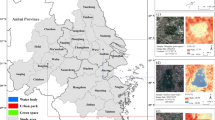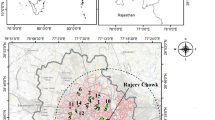Abstract
Urban parks can contribute to significant cooling effect for the city microclimate and, therefore, promote urban residents’ outdoor thermal comfort. As the enhancement of the urban heat island effect, understanding the cooling efficiency of urban park and associated determinants has become critical for maximizing the ecological benefits of urban ecological infrastructure. In this paper, we measured holistically the cooling efficiency of urban parks from a relative and absolute perspective by using the data envelopment analysis (DEA) model and Landsat 8 OLI/TIRS satellite imageries. We adopted two novel cooling effect indices to rank and identify the inefficient park: DEA-based cooling efficiency index for relative efficiency and park cooling intensity index (PCII) for absolute efficiency. A total of 146 urban parks within the Shanghai metropolitan city was selected to conduct the empirical research. The correlation analysis and machine learning techniques (XGBoost) were also used to examine the relationships between the characteristics of parks and two cooling effect indices. The findings revealed that the average cooling efficiency of urban park in summer was approximately 2.7 times higher than that in winter. Park size and vegetation greenness (NDVI) were identified as the dominant factors for park cooling efficiency. Moreover, larger parks with area > 5 ha showed better cooling performance on average. In the current study area, increasing the water body coverage ratio also played an important role on the improvement of cooling effect in both summer and winter. The research findings could provide valuable references for designing urban parks and for urban planning to maximize the cooling benefits and mitigate the UHI effects.











Similar content being viewed by others
Data availability
Not applicable.
Code availability
Not applicable.
References
Aflaki A, Mirnezhad M, Ghaffarianhoseini A, Ghaffarianhoseini A, Omrany H, Wang ZH, Akbari H (2017) Urban heat island mitigation strategies: a state-of-the-art review on Kuala Lumpur, Singapore and Hong Kong. Cities 62:131–145
Banker RD, Charnes A, Cooper WW (1984) Some models for estimating technical and scale inefficiencies in data envelopment analysis. Manag Sci 30:1078–1092
Brown RD, Vanos J, Kenny N, Lenzholzer S (2015) Designing urban parks that ameliorate the effects of climate change. Landsc Urban Plan 138:118–131
Cao X, Onishi A, Chen J, Imura H (2010) Quantifying the cool island intensity of urban parks using ASTER and IKONOS data. Landsc Urban Plan 96:224–231
Charnes A, Cooper WW, Rhodes E (1978) Measuring the efficiency of decision making units. Eur j Oper Res 2(6):429–444
Chen AL, Yao XA, Sun RH, Chen LD (2014) Effect of urban green patterns on surface urban cool islands and its seasonal variations. Urban for Urban Green 13:646–654
Chen T, Guestrin C (2016) XGBoost: a scalable tree boosting system. In Proceedings of the 22Nd ACM SIGKDD International Conference on Knowledge Discovery and Data. Mining. ACM, New York, NY, USA, 785–794. https://doi.org/10.1145/2939672.2939785
Chibuike EM, Ibukun AO, Abbas A, Kunda JJ (2018) Assessment of green parks cooling effect on Abuja urban microclimate using geospatial techniques. Remote Sensing Applications: Society and Environment 11:11–21
Dai ZX, Guldmann JM, Hu YF (2018) Spatial regression models of park and land-use impacts on the urban heat island in central Beijing. Sci Total Environ 626:1136–1147
Deilami K, Kamruzzaman M, Liu Y (2018) Urban heat island effect: a systematic review of spatio-temporal factors, data, methods, and mitigation measures. Int j Appl Earth Obs Geoinf 67:30–42
Dronova I, Friedman M, McRae I, Kong FH, Yin HW (2018) Spatio-temporal non-uniformity of urban park greenness and thermal characteristics in a semi-arid region. Urban for Urban Green 34:44–54
Du C, Ren H, Qin Q, Meng J, Zhao S (2015) A practical split-window algorithm for estimating land surface temperature from Landsat 8 data. J Rem Sens 7:647–665
Feng YJ, Liu M, Chen L, Liu Y (2016) Simulation of dynamic urban growth with partial least squares regression-based cellular automata in a GIS environment. ISPRS Int Geo-Inf 5:243
Feng YJ, Liu Y, Tong XH (2018) Spatiotemporal variation of landscape patterns and their spatial determinants in Shanghai, China. Ecol Ind 87:22–32
Feyisa GL, Dons K, Meilby H (2014) Efficiency of parks in mitigating urban heat island effect: an example from Addis Ababa. Landsc Urban Plan 123:87–95
Giridharan R, Emmanuel R (2018) The impact of urban compactness, comfort strategies and energy consumption on tropical urban heat island intensity: a review. Sustain Cities Soc 40:677–687
Hersbach H, Bell B, Berrisford P et al (2020) The ERA5 global reanalysis. Quart j r Met Soc 146:1999–2049
Huang GB, Zhu QY, Siew CK (2004) Extreme learning machine: a new learning scheme of feed forward neural networks. In: Proceedings of the international joint conference on neural networks. IEEE. 985–90
Huang GB, Zhu QY, Siew CK (2006) Extreme learning machine: theory and applications. Neurocomputing 70:489–501
Hwang YH, Jie Q, Lum G, Kwang Y, Chan D (2015) Micro-scale thermal performance of tropical urban parks in Singapore. Build Environ 94:467–476
Jenerette GD, Harlan SL, Buyantuev A, Stefanov WL, Declet-Barreto J, Ruddel BL, Myint SW, Kaplan S, Li XX (2016) Micro-scale urban surface temperatures are related to land-cover features and residential heat related health impacts in Phoenix, AZ USA. Landsc Ecol 31:745–760
Kong F, Yin H, James P, Hutyra LR, He HS (2014) Effects of spatial pattern of greenspace on urban cooling in a large metropolitan area of eastern China. Landscape Urban Plann 128:35–47
Li HD, Meier F, Lee XH, Chakraborty T, Liu JF, Schaap M, Sodoudi S (2018) Interaction between urban heat island and urban pollution island during summer in Berlin. Sci Total Environ 636:818–828
Lin WQ, Yu T, Chang XQ, Wu WJ, Zhang Y (2015) Calculating cooling extents of green parks using remote sensing: method and test. Landsc Urban Plan 134:66–75
Lin BS, Lin CT (2016) Preliminary study of the influence of the spatial arrangement of urban parks on local temperature reduction. Urban for Urban Green 20:348–357
Lin Y, Jim CY, Deng JS, Wang ZF (2018) Urbanization effect on spatiotemporal thermal patterns and changes in Hangzhou (China). Build Environ 145:166–176
Liu YX, Peng J, Wang YL (2018) Efficiency of landscape metrics characterizing urban land surface temperature. Landsc Urban Plan 180:36–53
Masoudi M, Tan PY, Liew SC (2019) Multi-city comparison of the relationships between spatial pattern and cooling effect of urban green spaces in four major Asian cities. Ecol Indic 98:200–213
Oke TR (1982) The energetic basis of the urban heat island. Q j r Meteorol Soc 108:1–24
Oliveira S, Andrade H, Vaz T (2011) The cooling effect of green spaces as a contribution to the mitigation of urban heat: a case study in Lisbon. Build Environ 46:2186–2194
Saaroni H, Amorim JH, Hiemstra JA, Pearlmutter D (2018) Urban green infrastructure as a tool for urban heat mitigation: survey of research methodologies and findings across different climatic regions. Urban Climate 24:94–110
Skoulika F, Santamouris M, Kolokotsa D, Boemi N (2014) On the thermal characteristics and the mitigation potential of a medium size urban park in Athens. Greece Landsc Urban Plan 123:73–86
Srivanit M, Hokao K (2013) Evaluating the cooling effects of greening for improving the outdoor thermal environment at an institutional campus in the summer. Build Environ 66:158–172
Sueyoshi T, Yuan Y, Goto M (2017) A literature study for DEA applied to energy and environment. Energy Economics 62:104–124
Sugawara H, Shimizu S, Takahashi H, Hagiwara S, Narita KI, Mikami T, Hirano T (2016) Thermal influence of a large green space on a hot urban environment. J Environ Qual 45:125–133
Sun R, Chen L (2012) How can urban water bodies be designed for climate adaptation? Landsc Urban Plann 105:27–33
Sun YW, Gao C, Li JL, Li WF, Ma RF (2018) Examining urban thermal environment dynamics and relations to biophysical composition and configuration and socio-economic factors: a case study of the Shanghai metropolitan region. Sustain Cities Soc 40:284–295
United Nations (2018) World Urbanization Prospects: the 2018 Revision, Highlights, Department of Economic and Social Affairs, New York, United Nations
Wang LN, Chang J, Zheng XR, Liu J, Yu MZ, Liu LL, Yang Y, Zhang HG (2018) Survey of ecological environmental conditions and influential factors for public parks in Shanghai. Chemosphere 190:9–16
Xu M, Hong B, Mi JY, Yan SS (2018) Outdoor thermal comfort in an urban park during winter in cold regions of China. Sustain Cities Soc 43:208–220
Xu XY, Sun SB, Liu W, García EH, He L, Cai Q, Xu SJ, Wang JJ, Zhu JN (2017) The cooling and energy saving effect of landscape design parameters of urban park in summer: a case of Beijing, China. Build Environ 149:91–100
Yan H, Wu F, Dong L (2018) Influence of a large urban park on the local urban thermal environment. Sci Total Environ 622–623:882–891
Yang AS, Juan YH, Wen CY, Chang CJ (2017a) Numerical simulation of cooling effect of vegetation enhancement in a subtropical urban park. Appl Energy 192:178–200
Yang J, Guan YY, Xia JH (Cecilia), Jin C, Li XM (2018) Spatiotemporal variations in greenspace ecosystem service value at urban fringes: a case study on Ganjingzi District in Dalian, China. Sci Total Environ 639:1453–1461. https://doi.org/10.1016/j.scitotenv.2018.05.253
Yang J, Sun J, Ge QS, Li XM (2017b) Assessing the impacts of urbanization-associated green space on urban land surface temperature: a case study of Dalian, China[J]. Urban Forestry & Urban Greening 22:1–10. https://doi.org/10.1016/j.ufug.2017.01.002
Yu ZW, Guo XY, Zeng YX, Koga M, Vejre H (2018) Variations in land surface temperature and cooling efficiency of green space in rapid urbanization: the case of Fuzhou city, China. Urban for Urban Green 29:113–121
Yuan F, Bauer M (2007) Comparison of impervious surface area and normalized difference vegetation index as indicators of surface urban heat island effects in Landsat imagery. Rem Sens Environ 106:375–386
Zhang Y, Liu YF, Zhang Y, Liu Y, Zhang GX, Chen YY (2018) On the spatial relationship between ecosystem services and urbanization: a case study in Wuhan, China. Sci Total Environ 637–638:780–790
Acknowledgements
This work was sponsored by K.C. Wong Magna Fund in Ningbo University and National Natural Science Foundation of China (41771174), (41571018), and (41871024). The authors also acknowledge Professor Weiwei Sun from Ningbo University for his assistance with the high-resolution remote sensing images acquisition.
Funding
See Acknowledgements section.
Author information
Authors and Affiliations
Contributions
All authors contributed to the study conception and design. Yanwei Sun: data collection, analyzing the results, and writing the article. Mengying Gao: data collection. Chao Gao: supervising the article and improving the expressions. Jialin Li: supervising the article. Renfeng Ma: supervising the article.
Corresponding author
Ethics declarations
Ethics approval
We confirm that this article is an original research and has not been published or presented previously in any journal or conference in any language (in whole or in part).
Consent to participate and consent for publication
We have consent to participate and publish.
Conflict of interest
The authors declare no competing interest.
Additional information
Publisher's note
Springer Nature remains neutral with regard to jurisdictional claims in published maps and institutional affiliations.
Rights and permissions
About this article
Cite this article
Sun, Y., Gao, C., Li, J. et al. Assessing the cooling efficiency of urban parks using data envelopment analysis and remote sensing data. Theor Appl Climatol 145, 903–916 (2021). https://doi.org/10.1007/s00704-021-03665-2
Received:
Accepted:
Published:
Issue Date:
DOI: https://doi.org/10.1007/s00704-021-03665-2




